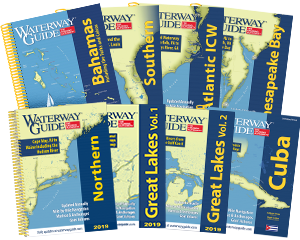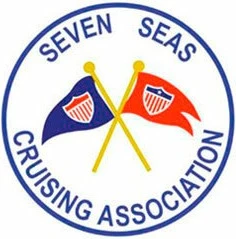Editor's Note: Waterway Guide would like to thank Exxon Mobil for permission to use the images supplied on the websites of the Exxon Mobil Historical Collection at the Dolph Briscoe Center for American History at the University of Texas at Austin, the Mandeville Special Collections Library at U.C. San Diego and the American Oil and Gas Historical Society in Washington, D.C.
Another version of this story ran in The Christian Science Monitor.
On March second, fans of Dr. Seuss will celebrate his 113th birthday. Today, Waterway Guide celebrates the “navy” he created for an ancestor of Exxon Mobil that altered his course from oil industry ad man to children’s book author.
Those who pick up a free copy of the 2017 Waterway Guide (WG) Magazine’s 70th Anniversary issue (available, at no cost, at marinas or online) will see a rare reprint of a 1959 advertisement for Esso Marine products, illustrated by Dr. Seuss.
Bruce Wells, Curator for the Oil and Gas Historical Society in Washington, D.C., said in a phone interview, "Back in 1935, while working in the ad department of the Standard Oil Company, Geisel was tasked with creating a campaign to launch Esso Marine Lube for the New York Motor Boat Show that was coming up in 1936." Esso (which still exists in Europe today) was part of Standard Oil which today is part of Exxon Mobil.

The WG illustration features a classic Dr. Seuss man in a black suit with fringed epaulettes, derby/bowler hat, holding a striped parasol as he pilots a freakish, steam-powered, craft with oddly bent paddle wheels.
“’I can always tell a man from the cut of his jib,’ says Captain Taylor,” the ad copy read. “Just as I can tell the quality of a gasoline by the sound of my engine.” Captain Taylor is a fictional character who routinely dispensed tongue-in-cheek boating advice throughout the series.
The ad is one of many chosen from various advertisers that the magazine’s staff picked at random to pull from archival copies and sprinkle throughout the issue to give it a retro feel for the 70th anniversary. It is the only Seuss-powered ad in the WG archive. It came from the WG Northern Edition book of 1959.
"We really had no idea of the historical significance of the ad when we put it into the magazine, except from our own perspective," Says Ed Tillett, editor-in-chief and general manager of Waterway Guide (WG) Media of Deltaville, Virginia. " During a staff meeting it became a topic of conversation that Dr. Seuss had illustrated it. When we dug into it, this treasure trove of history all came to light."
Gregg Philipson, vice president of Softex Inc. information technology, of Austin, Texas is a nationally known collector of Seuss’ works and an expert on his advertising works. He assisted Waterway Guide via both phone interviews and emails in reconstructing the history of the advertisement. This led to the story of Dr. Seuss’ Navy.
In 1935 Geisel was tasked with creating an epic campaign to launch Esso Marine Lube for the New York International Boat Show coming up in 1936. Esso (which still exists in Europe today) was part of Standard Oil which today is part of Exxon Mobil.

Geisel and his colleagues generated his magnum opus to the ad game, an interactive advertising campaign called “Seuss Navy.” The campaign included the creation of three, 30-page, booklets pairing his famously whacky characters with “his first foray into creating rhyming storylines as books,” according to Philipson.
Geisel once noted that his experience at Standard Oil “taught me conciseness and how to marry pictures with words.”
He conjured up everything from mermaids and creatures of the deep, to a Navy Seal that was an actual seal.
In “An informal reminiscence” at his alma mater, Dartmouth College, Geisel quipped that his contract with Standard Oil was so restricting that in order to satisfy his creative urges he was driven to become an author. "I would like to say I went into children's-book work because of my great understanding of children,” he said. “I went in because it wasn't excluded by my Standard Oil contract."
According to Phillipson, Seuss Navy was wildly popular in its day. Those who signed up were mailed an elaborately illustrated certificate, membership card and one of three rhyming story books for grownups written and illustrated by Seuss. Seuss Navy “Admirals” were then eligible to participate in all sorts of contests, games, social events and boat races for a variety of merchandise/prizes.
A search of various auctions reveals that those who have Seuss Navy Esso items are sitting on a gold mine. Prices for a membership card alone start around $300, complete card and certificate sets start at $500. The original booklets make collectors swoon shortly after opening their wallets.


Seuss Navy became a social network. The New York Times’ archive holds notices from 1938 announcing the annual Seuss Navy “luncheon and frolic” at a swanky hotel of the day.
Over 2,000 Seuss Admirals were minted, more than the U.S. Navy. Yet few today even know it existed, except, perhaps those who stumble across some of the marketing goodies that still linger on eBay.

"Starting small at one of the motor boat shows [the 31st Annual National Motor Boat Show at Grand Central Palace in NYC, January 17, 1936], we printed up a few diplomas, and we took about fifteen prominent people into membership —Vincent Astor and sailors like that, who had tremendous yachts — so we could photograph them at the boat show receiving their certificates,” Geisel told Dartmouth researchers.
"We waited to see what happened,” Geisel said. “Well, Astor and Guy Lombardo and a few other celebrities hung these things in their yachts. And very soon everyone who had a putt-putt wanted to join the Seuss Navy.”
It turns out that the WG ad has a story of its own that takes us straight into one of Seuss' three storybooks for Esso.
In a phone interview, Dr. Charles Cohen of Quincy, Mass., author of five books on Seuss including, “The Seuss, the Whole Seuss and Nothing but the Seuss: A Visual Biography of Theodor Seuss Geisel” says the WG ad, was actually drawn in 1947 for the third illustrated story booklet of the Seuss Navy campaign.
It was reprinted in 1959 when Esso Marine rebooted the 1930s campaign to capitalize on the newfound success of their former employee when “The Cat in the Hat” became popular.
The WG ad comes from Seuss’ third booklet “The Log Of The Good Ship” a satiric guide for boaters, circa 1947 that poked fun at novice boaters, giving them wrong-headed advice.

Example: The first thing is to establish yourself as a dashing fellow and fearless boatsman. You will see old men, who have been handling boats all their lives, pussyfooting around the club anchorage at slow speeds and giving everything a wide berth, but set this down to the conservatism of old age and prove yourself of a different stamp. The first time you bring your boat into the anchorage, open the throttle, advance the spark, and let her whoop. The bigger stern wave she drags the better...
The forward that accompanies the image in question in The Log explains that this booklet is intended to follow same satiric vein as the first two:
...no sooner had the literate members of the yachting fraternity had time to assimilate the wisdom packed between the covers of those books than the incidence of minor marine disasters skyrocketed several hundred per cent. Thousands of yachts were stranded, sunk, and damaged by accidents and mishandling of all sorts. Yachtsmen by the hundreds suffered nervous breakdowns from trying to follow our advice. Marine insurance underwriters debated the necessity of inspecting all insured vessels and doubling the premium rates on those aboard which copies of these books were found... Now, in the same helpful spirit in which they were published, we have brought this handsome, illuminated Ship's Log, in the sincere hope and confidence that it will help carry on the cataclysmic work begun by the earlier volumes.
Regarding the epaulets on the guy piloting the boat--Ted differentiated between captains, commodores, and admirals by the amount of frills and affectation in their dress. This boating "newbie" is trying to impress others but the impression he gives is exactly the opposite of the one he intended. Therefore, Cohen believes, the "cut of his jib" remark is simply part of "making fun" of the inexperienced yachtsman.
Seuss Navy certificates and marketing paraphernalia were produced from 1939 through 1949, even after Geisel left Esso to join the war effort in 1943.
In the Dartmouth interview Geisel concluded, "They [Esso] put advertising on them, and the Navy promptly died. The fun had gone out of it, and the Seuss Navy sank."
Fortunately, that singular Waterway Guide ad from 1959 resurfaced and became a beacon to guide us all back to this largely forgotten piece of the beloved author’s naval history.
If you own any Seuss Navy materials let us know. Send a photo and your Seuss story to [email protected].












